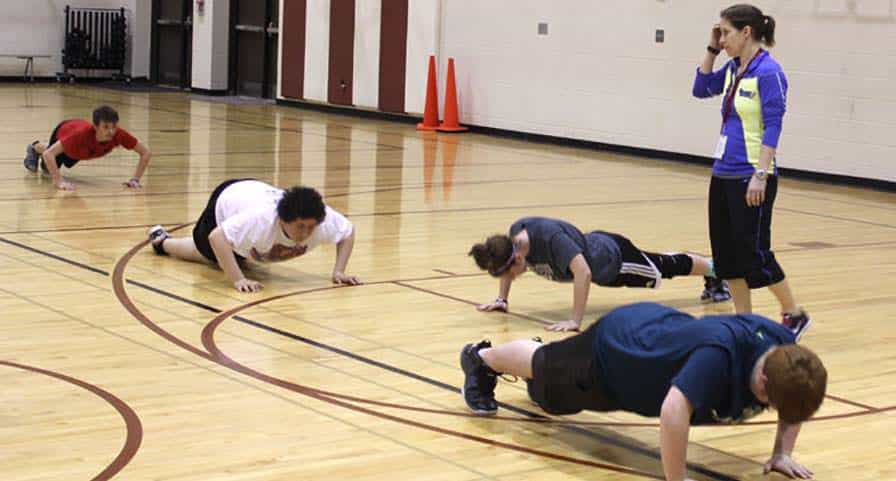Sept. 13, 2016
One of our teaching partners, Elizabeth Luck, is flipping the script in an effort to get more from her students this year.
The 2013 Iowa Middle School PE Teacher of the Year will require her Oskaloosa Middle School students to take charge of the learning process, designing each day’s lesson and pushing each other to reach her prescribed goal.
“I give them the goal for the day, but they choose how they’re going to meet it,” Luck said.
Flipped Classroom Learning
At IHT, we’ve noticed educators turning to a flipped classroom model to bring students into the teaching process. “One way to foster student engagement and to facilitate active learning is to give students the opportunity to choose what they will do to learn and practice,” wrote Aaron Sams and Justin Agilo for eschoolnews.
The flipped classroom model often has students using videos to learn new concepts at home and then demonstrating their mastery in class. Essentially, classwork has become homework and homework has become classwork. “In a flipped class, the time that a teacher once spent delivering new content can be used catching and correcting each student’s misconceptions,” Sams wrote.
Luck’s homework helps students understand how to create a good workout. As students demonstrate they understand the concept and are working toward their goal, Luck transitions from leader to observer.
“Instructions are given at the beginning of class and then the teacher becomes the ‘assistant’ to the student as they move through the workout,” Luck said. “I ask them simple things like ‘are you in the yellow zone?’ The goal is to make them think about what they are doing to accomplish the goal.”
Luck will be using our IHT Spirit System and the IHT ZONE wrist heart rate monitors to run a pilot program based on the flipped classroom principles. Luck’s classes will take a leading role in designing the class workout for the day based on criteria set forth in a lesson.
“We make sure that the students have the prior knowledge to be able to create a workout that meets the correct criteria,” Luck said. “I give them the goal for the day but allow them to choose how they are going to meet it.”
Luck sets class goals requiring students to spend different amounts of time in the different heart rate zones — blue, yellow or red. Most of Luck’s goals call for students to exercise with their heart rates in the yellow, also known as optimal, heart rate zone.
“I will write on the board a minimum time that they need to spend in the zone,” she said. “There are days that I give them several [activity] choices and they need to choose which one will help them achieve the goal.”
Personalized Learning
With the heart rate monitors providing data directly to Spirit, students can assess their performance immediately after class. While the monitors allow students to see their progress, Luck wants students to learn more.
“Also with the use of the heart rate monitors, it helps them understand what it should ‘feel like’ to be in an HR zone that helps improve their fitness level,” she said.
Students can reinforce that feeling with the personal reports received from the IHT Spirit System after class. Reports show whether the student met the daily goal and provide a detailed analysis of the workout, including time spent in each heart rate zone, Luck said.
Goals are specific to each individual student. Luck can measure each student’s individual progress based on whether they reach their daily goal, a key component of the personalized learning model, according to Luck.
Prepping for academic success, and beyond
Luck hopes the flipped classroom model empowers students to work hard and improve their fitness, allowing them to transition from PE into English, math, science and social studies more ready to learn.
“Students who have Physical Education before a tough class should be able to go in and focus better after being active,” she said.
Oskaloosa’s pilot program will track academic results and the students’ PE performance. Luck wants to measure students’ academic progress based on a standardized test administered each year. By including that measure in the student’s Spirit System profile, she’ll be able to track progress year over year.
“I plan on entering at least one of our annual standardized tests into the system,” she said. “Then we can use this data to find connections between PE and academic success. We want to show that that more active students will see higher achievement in the classroom.”
By keeping track of the data through IHT’s Spirit System, Luck can accomplish two things that every PE teacher can learn from.
“The goal is to be able to track their fitness testing from year to year as well as allowing the students to see how being physically active and fit will help be more successful in other parts of their lives as well,” she said.
For more information on the flipped classroom model, contact Luck at lucke@oskycsd.org.


